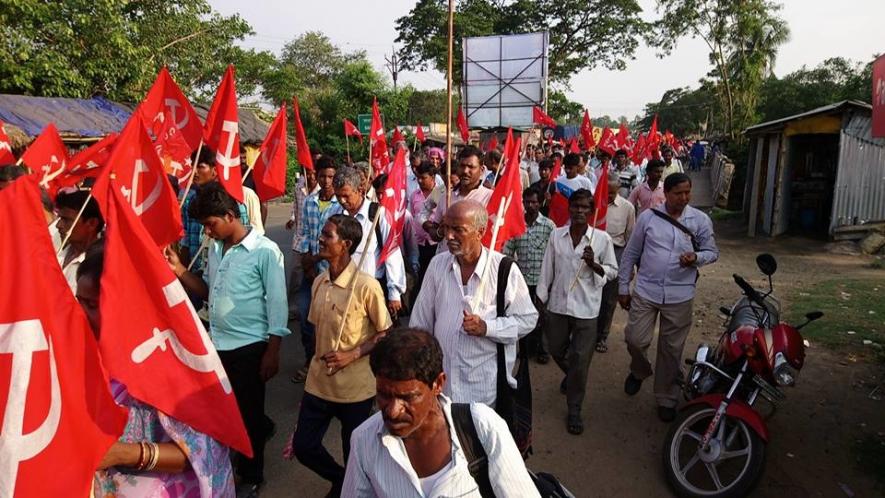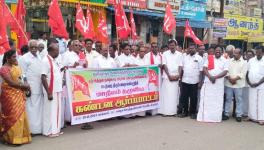One Year After Mandsaur Killing: A Year of Struggle of Indian Peasantry Against the Anti-farmer Government

Image Coutesy: Facebook
As the country observes one year of Mandsaur police firing, various farmers’ organisations took to streets across the country to mark their dissent against the Modi government and its anti-farmer policies, and to commemorate the martyr farmers. On June 6, 2017, the BJP-led state government in Madhya Pradesh had gunned down six farmers who were protesting – seeking guaranteed remunerative prices for their agricultural produces and freedom from indebtedness.
The All India Kisan Sangharsh Coordination Committee (AIKSCC), the umbrella body consisting about 193 farmers and peasant organisations, observed the first anniversary of the killing of farmers in Mandsaur as Mandsaur Shaheed Kisan Smriti Diwas. A day-long fast was also observed at Takravat village of Mandsaur. AIKSCC also took out a torch rally in Bhopal on the evening of June 4. Following this, on June 5, a commemorative meeting was held with villagers of Buda, in Mandsaur. The AIKSCC also demanded that there should be murder charges against the police personnel responsible for the killing.
AIKSCC – country’s largest platform of farmers’ organisations, which had been created in response to Mandsaur killing – took up issues of farmers in India, has been highlighting the depth of the agrarian crisis, and has campaigned and conducted Yatras to highlight the struggle of farmers and agricultural workers.
The year since Mandsaur killing has witnessed a series of farmers’ protest across the country including Kisan Long March in Maharashtra, Kisan Mukti farmers’ protests in Sikar and other parts of Rajasthan, struggle of Uttar Pradesh farmers and Himachal farmers and Tamil Nadu farmers’ protest in the national capital among others.
Loan waivers for farmers, implementation of Swaminathan committee recommendations including the Minimum Support Price (MSP), right to land, scrapping of forced land acquisition drive conducted in the name of various projects and increase in pension for farmers and agricultural workers were some of the key demands during all these protests.
In July 2017, the national capital witnessed a different kind of protest staged by the farmers from Tamil Nadu. The farmers, who had demonstrated a 41-day protest in Delhi earlier in 2017, returned to Delhi with skulls and bones of the farmers – who had committed suicide – to resume their protest, demanding loan waiver and drought relief package. During the protest, which had been continuing for months, the farmers put mice and snakes in their mouths, conducted mock funerals and stripped at Raisina Hills to mark their dissent. These series of protests were called off when the state Chief Minister Edappadi Palaniswami promised to waive off the loans taken from the nationalised banks.
In September 2017, Rajasthan’s Sikar district, which has a profound history of mass movements, had witnessed a massive farmer uprising. Thousands of farmers under the banner of All India Kisan Sabha (AIKS) occupied the streets and government offices to highlight their long pending demands. Sikar farmers had put forward a charter of demands: more fund allocation for MGNREGA, higher wages and more days of work, pension of Rs 5,000 a month for the farmers and agricultural workers above 60 years, effective crop insurance, protection of crops from stray cattle and wild animals, subsidised electricity and revoke of the cattle trade ban order.
The mass movement, which was led by Amra Ram of AIKS, had garnered massive support from all sections of the society. The BJP-led state government tried its best to disrupt the peaceful protest using the state machinery. But, the magnitude of the protest made the government accept the demands of the farmers.
On November 20-21, 2017, more than 50,000 farmers from different parts of the country had gathered in Delhi for the Kisan Mukti Sansad (Farmers’ Liberation Parliament), putting forward the two key demands: better prices for produce and debt relief. The Sansad had begun with a Mahila Sansad (Women’s Parliament) highlighting the role of women as farmers.
During the Kisan Sansad, two Bills – on remunerative prices and loan waivers – were presented by Hannan Mollah of AIKS and Raju Shetty of the Swabhimani Shetkari Sangathana- for, by and of the farmers.
In the run-up to the Kisan Mukti Sansad, AIKSCC led a Kisan Mukti Yatra covering a distance of more than 10,000 kilometers all over the country. Raising the consciousness over the condition of farmers, AIKSCC reached out to farming and non-farming communities, and tried to build unity between rural and urban India. The first phase of the Yatra, which had been flagged off from Mandsaur, culminated in Delhi by the mid of July 2017, covering six states: Madhya Pradesh, Maharashtra, Gujarat, Rajasthan, Uttar Pradesh and parts of Haryana.
The second phase of Kisan Mukti Yatra covering Southern states Telangana, Andhra Pradesh, Tamil Nadu, Kerala and Karnataka had started from Hyderabad on September 16, 2017, and concluded in Bengaluru on September 23, 2017. The third phase – eastern leg – of the Yatra from October 29, 2017, to November 5, 2017, had engaged with the masses from Odisha, Chhattisgarh, Jharkhand, South Bihar and West Bengal.
In the final phase of the Yatra – the Northeastern leg of the Yatra – gatherings were conducted in different villages. With a mass gathering at Dighalipukhuri in Guwahati, Assam, on November 12, 2017, in the presence of hundreds of farmers and agricultural workers along with others, the Yatra was concluded. Throughout its long way, the Yatra was embraced by various sections of the society including peasants, agricultural workers, trade unionists, Adivasis, Dalits, students among others, irrespective of urban-rural divide.
The momentum of the Kisan Mukti Yatra and Kisan Sansad further continued and AIKSCC campaigned widely across the nation against the anti-farmer policies of the BJP-led state governments. The government always stood along with the corporates and framed policies, which were wrapped up in nationalism, for them. They also made legislation like the Seed Bill, Biotechnology Regulatory Authority of India Bill, and Pesticide Management Bill for the sake of the corporates.
On February 22, despite the state government’s crackdowns and arrests, farmers from Rajasthan demonstrated a protest march in Jaipur. After the protests, the farmers had decided to meet PM Modi who had announced a visit to Jhunjhunu on March 8. The state government, however, had imposed section 144 of the IPC, prohibiting an assembly of more than four people in an area, in Sikar district on March 1.
Again, in the first week of March 2018, Maharashtra saw an unparalleled movement. On March 6, thousands of farmers including women and tribals set out on their long march from Nashik under the flagship of AIKS. The long march, which had gained mass momentum as it progressed, and entered Mumbai on March 11 midnight. To avoid causing any inconvenience to the students appearing for board exams on the next day, the farmers walked during the midnight to their final destination – Azad Maidan – to press for their demands. The farmers, who fought for their rights without creating any kind of inconvenience to the Mumbai’s daily routine, got showered with mass solidarity from the middle-class of the city.
Along with their main demands, the farmers demanded MSP for dairy products, implementation of the Forest Rights Act, and end of the forceful land acquisition. In Maharashtra, a section of farmers was evicted from their farming land in the name of various projects including Mumbai-Ahmedabad bullet train project, Delhi-Mumbai industrial corridor and Mumbai-Nagpur expressway etc.
As the farmers, who led their struggle hand in hand with the Ashok Dhawale, JP Gavit, Ajit Nawale and Kisan Gujar – the AIKS leadership – were very determined, the BJP-led state government was forced to accept the demands of the farmers, and they had sought one and half months of time to implement the demands of farmers.
Right after the historic Kisan Long March, thousands of farmers from Uttar Pradesh gathered in Lucknow as per AIKS’ ‘Lucknow Chalo’ protest call for a ‘Kisan Pratirodh Rally’ with a slogan of “Aatmhatya nahi, sangharsh karenge” (No to Suicide, Unite to Fight). In the protest, the farmers had raised the demands like their counterparts in other states. Apart from those demands, Uttar Pradesh farmers demanded lower prices of electricity and fertilizers.
Again, Himachal Pradesh farmers under the leadership of AIKS encircled the state assembly in Shimla on April 3. One of the main demands, along with the common demands of the farmers, was to stop targeting farmers in the name of eviction. They demanded distribution of the land to the farmers. In the state, 65 per cent of the population is into farming. However, the farming land consists of only 11 per cent of the total land. Thus, many small and marginal farmers have been cultivating their produces on the forest land. But, the government and authorities have been evicting the farmers for encroaching on the forest land.
Though the farmers marked their victory through the Kisan Long March, the state government is yet to implement the promises. Owing to the betrayal of the government, farmers have resumed their protests in Maharashtra, including the recent protest of dairy farmers and protests in Dahanu against the forceful land acquisition.
As the protests continue, on August 9 – the anniversary of historic Quit India Movement – AIKS’s campaign of collecting signatures of 10 crore farmers will culminate at district headquarters across the country as the farmers hand the memorandum over with charter of their demands to District Magistrates, while they ask the BJP to quit India: ‘Bharat Chhodo’. The plight of farmers is likely to continue till BJP quits India.
Get the latest reports & analysis with people's perspective on Protests, movements & deep analytical videos, discussions of the current affairs in your Telegram app. Subscribe to NewsClick's Telegram channel & get Real-Time updates on stories, as they get published on our website.























